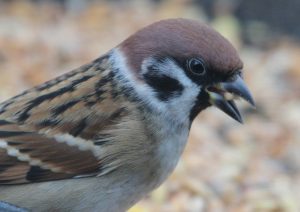 In most gardens, at this time of the year, the commonest bird is the chaffinch. At the three feeding stations in my garden the total is well over fifty depending on the time of day. The reason for such numbers is partly because in the Highlands they are generally a very common bird. In Scotland there are estimated to be 1 – 1.5 million pairs and this is reflected in the numbers in the Highlands. Another reason they are common in gardens is their adaptability to the wide range of feeders and feed we put out. The birds will go for feeders filled with niger, sunflower seeds, suet balls and peanuts as well as any food scattered on the ground or on bird tables. Chaffinches, despite the weather earlier this year, had a good breeding season and many managed to bring off two broods of young.
In most gardens, at this time of the year, the commonest bird is the chaffinch. At the three feeding stations in my garden the total is well over fifty depending on the time of day. The reason for such numbers is partly because in the Highlands they are generally a very common bird. In Scotland there are estimated to be 1 – 1.5 million pairs and this is reflected in the numbers in the Highlands. Another reason they are common in gardens is their adaptability to the wide range of feeders and feed we put out. The birds will go for feeders filled with niger, sunflower seeds, suet balls and peanuts as well as any food scattered on the ground or on bird tables. Chaffinches, despite the weather earlier this year, had a good breeding season and many managed to bring off two broods of young.
With chaffinches dominating the scene in gardens it is easy to overlook other birds especially if only single birds are around. A good example is the brambling that is closely related to the chaffinch and superficially resembles them. At this time of the year other single birds that can go un-noticed are the blackcap, lesser redpoll or even the rare hawfinch. Another bird that is easily missed, especially if you have numbers of house sparrows at the feeders or on the tables, is the tree sparrow. Compared with the house sparrow that has around 800,00 pairs in Scotland the tree sparrow has a mere 7,000 pairs. It is also quite uncommon in the Highlands being confined to areas around the Moray Firth.
However, each year I have two or three single tree sparrows turning up in my garden but only staying for a few days. When I do notice them it is the rich chocolate crown feathers, as can be seen in the photograph I took, that gives them away. They are very dominant birds and at feeders will see off any other small birds such as chaffinches and house sparrows. I well remember when I lived down south and had a series of 25 small nestboxes in woodland. For a few years there were a variety of birds nesting in them from great tits to blue tits until the tree sparrows arrived on the scene. Within two years all the nestboxes had been taken over by the tree sparrows. In many cases they pushed out the existing birds and built their own nest and laid eggs on top of the existing birds nest and eggs. The fact that they breed in such loose colonies is interesting as why do single birds turn up in gardens occasionally? A mystery indeed.
So if you want tree sparrows then put up a small number of nestboxes together and you might be lucky. The entrance hole needs to be 28 mm diameter and once they have colonised them do not disturb them as, for some unknown reason, they readily desert. Outwith nestboxes they will nest in holes or crevices in trees, buildings, cliff faces and in banks. They will also, unusually, take over old sand martin holes and after my experience with them taking over other birds’ nests I wonder if they would do this with the sand martins? Despite their apparent success tree sparrows are on the red list which means they are amongst the most threatened birds in the UK because the numbers are rapidly falling and their range contracting. So anything we can do to help the tree sparrow is well worthwhile.
Tags: highland birds
